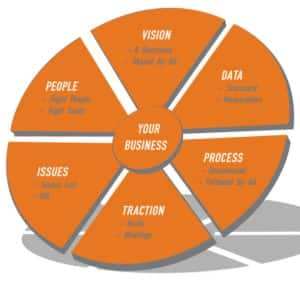Scaling Up vs EOS vs OKRs: Choosing the right goal management system for your growing business
Rapid business growth is something any founder is aiming for, but when it comes your way, it can be challenging to find the right goal management system.
Navigating the growth process requires the implementation of new management systems and greater effort to align the team around what matters. But which system is right for your scaling business?
In this post, we’ll break down the similarities and key differences between three of the most popular business methodologies: Rockefeller Habits or Scaling Up, Entrepreneurial Operating System Traction (EOS), and Objectives and Key Results (OKRs).
While all three derive from Peter Drucker’s management by objectives, they offer differing levels of complexity that present advantages and disadvantages depending on the organization implementing them.
Let’s jump into the methodologies!
The Rockefeller Habits, aka Scaling Up
Origin: The Rockefeller Habits or Scaling Up, as introduced by Verne Harnish, founder of Entrepreneur’s Organization (EO), in his books Mastering the Rockefeller Habits and Scaling Up, is a holistic strategic planning and business management methodology that guides businesses in the areas of people, cash, strategic planning, and execution. The principles are based in part on the historic example of Rockefeller’s Standard Oil and have been adopted by numerous scaling firms like Apple Tree Answers and Growth Cubed.
Summary: The Scaling Up methodology is anchored by the implementation of a daily huddle to improve communication. Also central to Scaling Up is the development of a grand strategic vision and core values. The framework for Scaling Up is built around a cycle of quarterly goal planning and tracking. The quarterly cycle allows you to break up your long term goals into achievable priorities that build toward your goals over time. Scaling Up has a strong emphasis on the high-level strategic plan, central of which is a “One-Page Strategic Plan” using Harnish’s 7 Strata of Strategy framework. The methodology also includes tools for assessing cash management and team alignment.

Who’s it for: Businesses of all ages and sizes use Scaling Up. But, the system is most valuable for organizations looking to spur growth through change management. The system can help leaders fully rethink their organization’s purpose, all the way from the highest level strategy to the day-to-day cash management and meeting rhythm. Like any habits, they take time to adopt but can be rolled out selectively over time. Given the depth of focus on strategy and cash, Scaling Up is especially effective for fast-growing businesses in the $10 to $200 million in revenue category.
Bottom line: Scaling Up is the most comprehensive of the systems described here. Each chapter of Scaling Up could be its own book. The components can be rolled out over time, though implementers benefit most quickly from the methodology’s ability to connect strategy with execution. The depth and focus of Scaling Up is especially helpful for organizations seeking a holistic transformation that powers growth.
Entrepreneurial Operating System (EOS)
Origin: Entrepreneurial Operating System was developed by Gino Wickman in his book Traction: Get a Grip on Your Business. Gino was a disciple of Verne Harnish and a founding member of Detroit’s EO chapter, an organization created by Harnish. As a result, EOS contains many similarities to Scaling Up but with some simplification.
Summary: EOS reduces the Scaling Up to its people and execution components. Like Scaling Up methodology, EOS utilizes Stephen Covey’s “Rocks”, a constrained set of goals that must be accomplished in the quarter. EOS focuses on weekly “Level 10 Meetings” with the leadership team, designed to identify, discuss, and solve problems.
Who’s it for: While EOS is also used across industries, its simplified tools make it appealing to the lower end of the SME market. The entire EOS system can be implemented in one quarterly session. In contrast, adopting all components of the more comprehensive Scaling Up requires a commitment over a longer period.
The Bottom Line: The critical components of EOS are virtually identical to what can be found in the other systems described. The Level 10 meeting provides an effective and detailed structure for solving problems as a leadership team. EOS’s most valuable and unique tools can easily be combined with methodologies like Scaling Up or OKRs to help the leadership team.
Objectives and Key Results (OKRs)
Origin: Introduced by Andy Grove in High Output Management and recently popularized by John Doerr in Measure What Matters, OKRs have helped companies like Intel and Google manage goals.
Summary: Objectives are the “What” is to be achieved. Key Results are the “HOW” the objective will be achieved. Key Results are typically specific and measurable. Key results typically encompass Key Performance Indicators (KPIs), by defining quantitative targets.
Who’s it for: Because OKRs are the simplest and most flexible framework, it is widely adopted and referenced. It can work for both personal and company goals. OKRs are easily adopted within the broader frameworks described above.
Bottom Line: OKRs focus exclusively on execution and provide just one tool for leaders. While this is fine for organizations focused solely on execution, many businesses may desire a more detailed system for connecting objectives to greater vision and day-to-day operations.
EOS vs Scaling Up vs OKRs Glossary
|
Scaling Up |
EOS |
OKRs |
Description |
|
|
Central document containing strategic vision for company. |
||
|
Objectives & Key Results |
3-7 Top things you need to accomplish in a quarter to move the business forward |
||
|
KPIs |
Leading indicators for how your business is executing on key objectives |
||
|
Daily Huddles, Weekly Team Meeting, monthly management meetings, quarterly planning |
Suggested meeting rhythm and structure |
||
|
Self-assessment for how well your business is operating. |
|||
|
5-10 guiding principles for your company. |
|||
|
Tool to ensure the right people are responsible for the right functions |
|||
| Tool to ensure every process is assigned to an owner | |||
| Preferred personality assessment | |||
|
Traction Tools |
Associated software |
Measurable Goals for Better Team Alignment
As is probably clear from the above chart, all of these frameworks boil down to the same basic tasks: developing a plan and aligning a team to specific, measurable, and time-bound goals. The experience of thousands of firms all around the world, as well as proprietary Align data, proves the effectiveness of a solid system of goal setting and tracking.
Scaling Up and EOS Traction provide the added benefit of more in-depth tools to help businesses think through developing strategy and operating day-to-day. The systems can also easily be combined, depending on needs. Scaling Up’s Daily Huddles can be used alongside EOS Level 10 weekly leadership meetings, for instance. Ultimately, the decision of which methodology will work best depends on the level of detail and breadth of scope desired by the leadership team.
According to David Scott, the three factors most critical to success with any system are people, process, and technology. Rock Habits and EOS provide some insight to people and processes with different angles and degrees of detail, while OKRs do not. The right framework for thinking about these two components typically requires some organizational experimentation with things like meeting structure and rhythm. No framework, however, dictates a single solution for the final component Scott describes, “the technology tools necessary to execute your mission and vision.”
On this blog, we’ve discussed the importance of having a single place for an organization to track strategy, tasks, and progress. While many tools exist, Align is the most flexible software because it is built to be able to manage all components of Scaling Up, the most comprehensive and detailed of the business management systems. For that reason, all of these business management systems will work in Align. Just as the systems described can be selectively combined depending on an organization’s needs, not all components of a business operating software need to be implemented at once.
At the end of the quarter, an organization’s success won’t be determined by the terminology they use in their businesses. Simply setting goals and hoping for the best will never be enough. As an organization grows, they may need to utilize various tools from separate methodologies. The need for great people and a centralized way to keep the whole organization aligned, however, will always remain indispensable factors for success, no matter the methodology.






